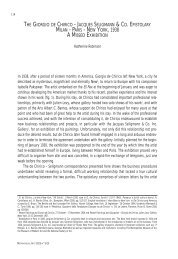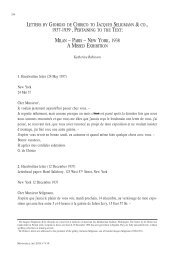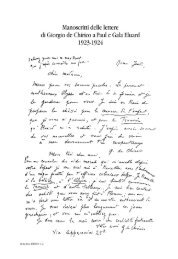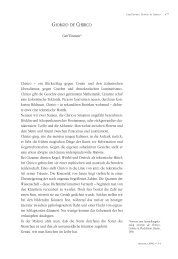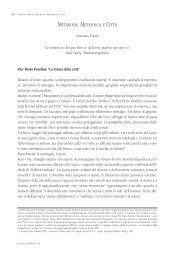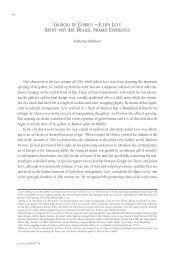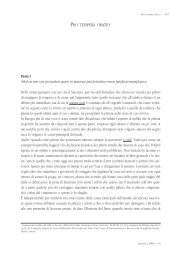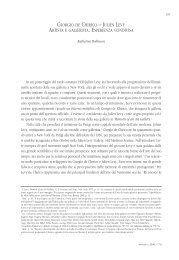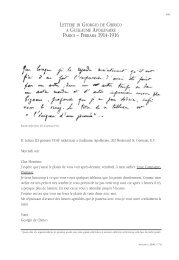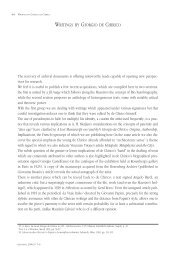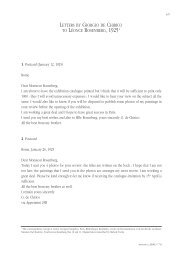Emplastic Oil - Fondazione Giorgio e Isa de Chirico
Emplastic Oil - Fondazione Giorgio e Isa de Chirico
Emplastic Oil - Fondazione Giorgio e Isa de Chirico
You also want an ePaper? Increase the reach of your titles
YUMPU automatically turns print PDFs into web optimized ePapers that Google loves.
178<br />
SALVATORE VACANTI: FROM MURAL PAINTING TO “EMPLASTIC OIL”<br />
Costume, <strong>de</strong> <strong>Chirico</strong> <strong>de</strong>picts himself holding the tools<br />
of the tra<strong>de</strong> and thus appears to celebrate the arduously<br />
attained discovery of the emulsion that he presumed<br />
to be the coveted secret of the Baroque<br />
Masters. Having noted the drying problems of emulsion<br />
painting, <strong>de</strong> <strong>Chirico</strong> began experimenting anew<br />
to resolve these issues. The result was the invention<br />
of another paint bin<strong>de</strong>r: “emplastic oil”. These experiments<br />
took place in Florence in Bellini’s home,<br />
where the <strong>de</strong> <strong>Chirico</strong>’s had moved after the first bombardment<br />
of Milan in the autumn of 1942. His new<br />
research is thus remembered in the Memoirs:<br />
It was the first large-scale bombardment of Milan […] a<br />
few days later we set out for Florence. Meanwhile<br />
fig. 12 G. <strong>de</strong> <strong>Chirico</strong>, Naked Self-portrait, 1942-1943, oil<br />
on canvas, Galleria Nazionale d’Arte Mo<strong>de</strong>rna, Rome autumn came […]. In Florence we stayed as guests for<br />
the whole of the winter with our friend Luigi Bellini the<br />
antique <strong>de</strong>aler. […] In Florence I continued to work. The new technique I was using achieved better<br />
results than those produced with emulsion. It was with emplastic oil that I painted my famous self-portrait<br />
in the nu<strong>de</strong>, which is perhaps the most finished painting that I have carried out so far. 86<br />
The second edition of the Memoirs reveals the formula for the new paint bin<strong>de</strong>r. The original 1945<br />
edition was updated in 1962 with new recollections and a small section entitled Tecnica <strong>de</strong>lla pittura<br />
(Painting Technique). In this section, un<strong>de</strong>r the entry Alcuni diluenti per la pittura ad olio (Some<br />
Diluents for <strong>Oil</strong> Painting) he <strong>de</strong>scribes how to produce a varnish with seven parts of raw linseed oil<br />
and one part of litharg 87 mixed over low heat. He explains that he learnt the method from Jean François<br />
Mérimée’s 1830 book on oil painting 88 published in Paris in 1830, and adds that the mixture must have<br />
been used by French and Italian painters from the eighteenth century. He then writes:<br />
To use this varnish, put it on the palette or in a can and dilute it with raw linseed oil in or<strong>de</strong>r to make<br />
it fairly fluid. The advantages of this emplastic oil are that brushstrokes of highly diluted paint do not<br />
run and do not lose their outline, and it is possible to place one stroke over another one without the<br />
second one cancelling out or displacing the first one. The principal quality of this varnish is its oiliness;<br />
it is the oiliness which allows each brushstroke to cling to the preceding ones by a suction effect;<br />
it is the same phenomenon as that of a suction cup. 89<br />
86<br />
G. <strong>de</strong> <strong>Chirico</strong>, The Memoirs…, cit., pp. 153 and 156.<br />
87<br />
Llitharge (PbO) was known by ancient Egyptians and used as a siccative: it accelerates the processes of oxidation and polymerization of the bin<strong>de</strong>r (oil<br />
or varnish), and thus allows it to quickly pass from a liquid state to a solid state. (See L. Traversi, Le vernici, in Preparazione e finitura <strong>de</strong>lle opere pittoriche,<br />
by C. Maltese, Mursia, Milan 1993, pp. 156-157.) Since Antiquity the most common siccatives have been oxi<strong>de</strong>s of lead and of manganese, such<br />
as those of Harlem and Courtrai. These were substantially employed throughout the nineteenth century and up until the time in which <strong>de</strong> <strong>Chirico</strong> writes.<br />
88<br />
J. F. L. Mérimée, De la peinture à l'huile, Huzard, Paris 1830 (facsimile reprint Puteaux, EREC, 1981).<br />
89<br />
G. <strong>de</strong> <strong>Chirico</strong>, The Memoirs…, cit., p. 239.<br />
METAPHYSICAL ART 2010|N° 9/10



